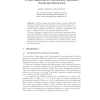Free Online Productivity Tools
i2Speak
i2Symbol
i2OCR
iTex2Img
iWeb2Print
iWeb2Shot
i2Type
iPdf2Split
iPdf2Merge
i2Bopomofo
i2Arabic
i2Style
i2Image
i2PDF
iLatex2Rtf
Sci2ools
DAGM
2005
Springer
2005
Springer
A Fast Algorithm for Statistically Optimized Orientation Estimation
Filtering a signal with a finite impulse response (FIR) filter introduces dependencies between the errors in the filtered image due to overlapping filter masks. If the filtering only serves as a first step in a more complex estimation problem (e.g. orientation estimation), then these correlations can turn out to impair estimation quality. The aim of this paper is twofold. First, we show that orientation estimation (with estimation of optical flow being an important special case for space-time volumes) is a Total Least Squares (TLS) problem: Tp ≈ 0 with sought parameter vector p and given TLS data matrix T whose statistical properties can be described with a covariance tensor. In the second part, we will show how to improve TLS estimates given this statistical information.
| Added | 26 Jun 2010 |
| Updated | 26 Jun 2010 |
| Type | Conference |
| Year | 2005 |
| Where | DAGM |
| Authors | Matthias Mühlich, Rudolf Mester |
Comments (0)

